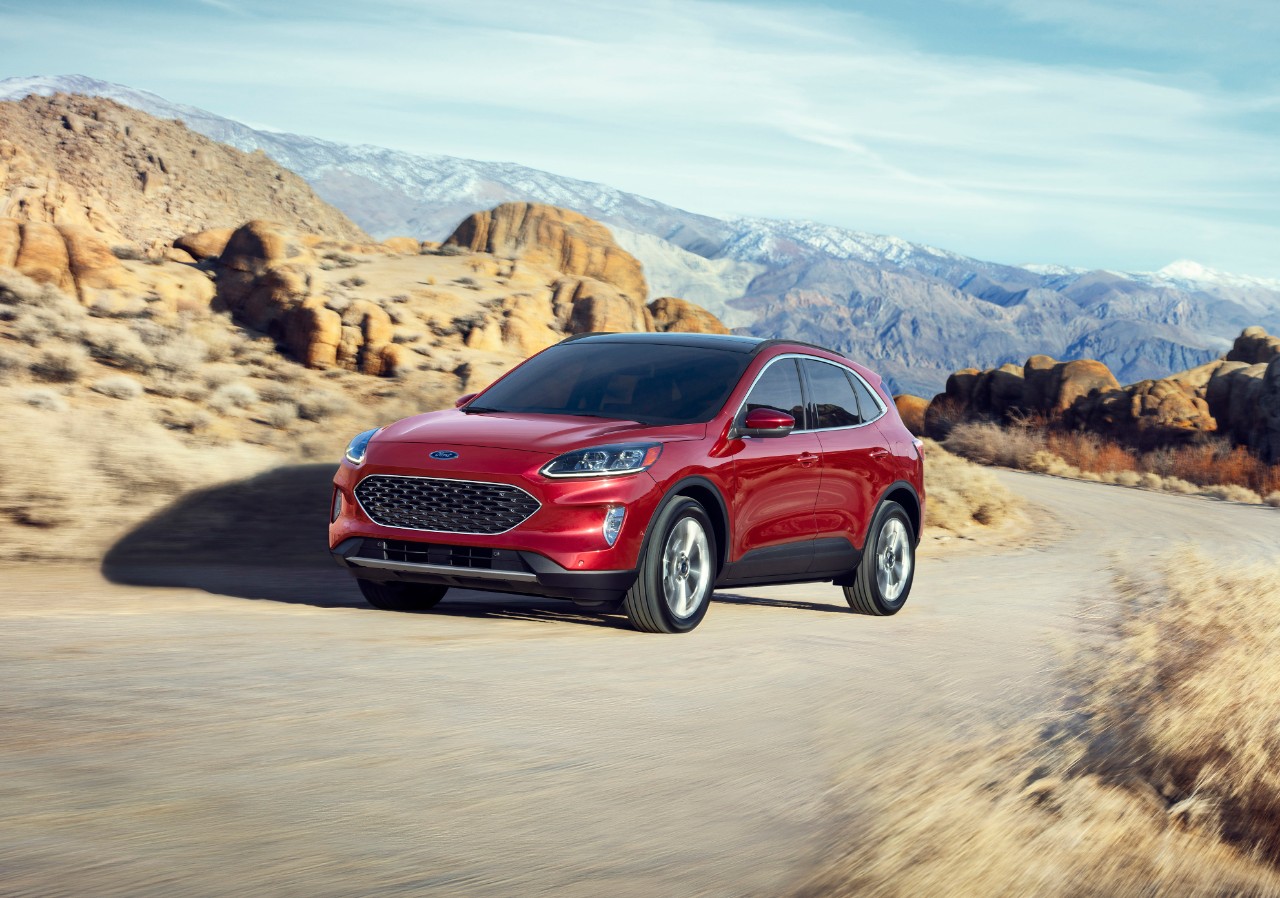
Ford brings three different 2020 Escape crossovers to the party, and any of them provides efficient and brisk transportation. Love driving? You’ll want the turbo-4. Love your money? Stick with the turbo-3. Love saving gas? Ford has two hybrids for you, both a gas-electric Escape and a coming plug-in hybrid.
We base this rating on what’s likely to be the most commonly purchased Escape, the front-drive SUV with the turbo-3-engine. That rates a 6 on our scale; if either the hybrid or the turbo-4 became the leaders, we’d add another point.
Buy an Escape S, SE, or SEL, and the 3,299-pound front-drive Escape comes with a 1.5-liter turbo-3 pegged at 181 horsepower and 190 pound-feet of torque. (A disclaimer: Ford recommends 91-octane gas for its turbo engines but rates them on less common 93-octane fuel. Why? Zero clue, so top output likely is lower than their quoted numbers). The turbo-3 has an encouraging note as it works to deliver reasonable acceleration. We weren’t granted much time in this version, just a short city loop that revealed moderate thrust and no sense that the turbo-3’s engine was shutting off a cylinder to save fuel under light loads. It’s coupled to an 8-speed automatic and can be fitted with a simple all-wheel-drive system that raises its curb weight and sends power to the rear wheels when the fronts begin to slip. More on that in a moment.
We spent more time in the Escape Titanium outfitted with a 2.0-liter turbo-4 rated at 250 hp and 280 lb-ft of torque, coupled to the 8-speed automatic and all-wheel drive, and outfitted with the same drive modes found on other models (Normal, Eco, Sport, Slippery, Snow/Sand). This is the engaging, quick-witted Escape, the one with acceleration to match its vivacious grip. Ford says both turbo engines are faster than the cars they replace, but doesn’t publish acceleration estimates; we’ll estimate the turbo-4 at below seven seconds in the 60-mph dash. In the Titanium, which comes with thicker acoustic glass, the turbo-4’s grainy sounds were well-muted, and Ford’s new shift programming permits more manual shift control; click a paddle and the Escape now holds a gear until it nears redline. The 8-speed judders sometimes in quick shifts, and its energetic turbo bounding and its frenetic turbo spooling have been tamed some, but fluid acceleration still sits a fingertip click away, from nearly any point in its rev range.
The base turbo-3 is rated to tow up to 2,000 pounds, while the 2.0-liter turbo-4 is rated to lug up to 3,500 pounds when properly equipped.
In sharp contrast to the previous crossover, the 2020 Escape rides better than it steers. Both attributes are standouts in a class that counts the Forester and CR-V as its leaders. Even on the 19-inch wheels and tires that come with the Titanium and turbo-4, the steady slaps and thuds of the old Escape’s tires have been subdued some. Even on 19-inch wheels the 2020 Escape snubs harsh impacts by smothering them with suspension travel and tire rubber. The gains in ride quality have smoothed over its hot-hatch persona, but the steering still firms up in sport mode while the whole car remains composed over moderately sized bumps. It’s no longer a rattler or a thumper. We’ll need more time with the base car and its 17-inch wheels and tires before we can judge its trade-offs properly.
Ford Escape Hybrid performance
Ford hasn’t offered an Escape hybrid since 2012, but the new model shares little with its blocky predecessor. For one, it’s fun to drive.
The Escape SE Sport and Titanium come standard with a gasoline-electric hybrid powertrain that pairs a 2.5-liter inline-4 to an electric motor and a 1.1-kwh lithium-ion battery pack. A continuously variable automatic transmission (CVT) sends power to the front or all-wheel wheels and the setup is good for 200 hp combined and 209 lb-ft. Ford said that the hybrid crossover SUV will be capable of hitting 85 mph on electric power alone.
Ford blots out this powertrain’s noise with lots of sound deadening and active noise cancellation, but it’s still in the fore enough to notice as we buzzed Kentucky horse country in the gas-electric crossover. With its emphasis on battery power and its unique transmission (a set of motors that couple and uncouple with engine power to act like a CVT), its powertrain feels more like it’s operated by remote, like a drone—but it’s responsive in the way that matters most. We saw upwards of 41 mpg indicated on the Hybrid’s tripometer, and were able to boost regeneration by putting it its transmission into L as often as low speeds and winding roads permitted. It’s one of the few ways the Escape Hybrid feels and acts like a hybrid; in steering feel and ride control it’s nearly the equal of the non-hybrid car, and that’s one thing Ford hopes will drive more shoppers toward it (and offset fuel economy of other Ford trucks in the process).
A 200-hp Ford Escape plug-in hybrid with an upsized 14.4-kwh lithium-ion battery is available. It can be charged in 3.5 hours on a Level 2 240-volt charging station for about 30 miles of electric-only range. The plug-in hybrid powertrain is only available with front-wheel drive, where it still checks in at a chunky 3,884 pounds.
Both hybrid versions can be run in full-electric mode given enough battery charge in reserve and an EV Charge mode tops off the battery during driving for electric-only use later in the plug-in Escape.
Review continues below

